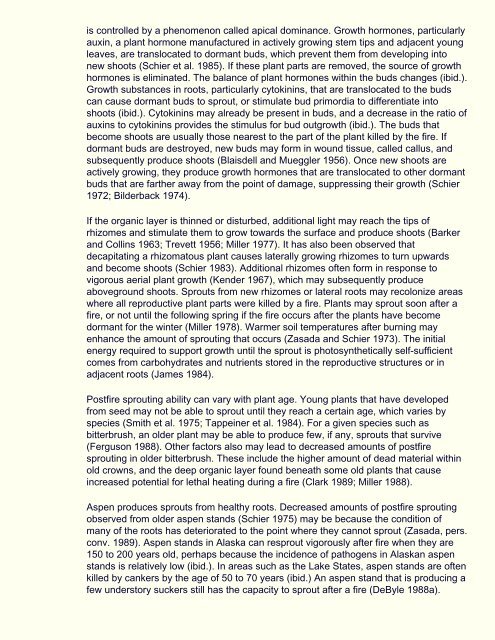FIRE EFFECTS GUIDE - National Wildfire Coordinating Group
FIRE EFFECTS GUIDE - National Wildfire Coordinating Group
FIRE EFFECTS GUIDE - National Wildfire Coordinating Group
Create successful ePaper yourself
Turn your PDF publications into a flip-book with our unique Google optimized e-Paper software.
is controlled by a phenomenon called apical dominance. Growth hormones, particularly<br />
auxin, a plant hormone manufactured in actively growing stem tips and adjacent young<br />
leaves, are translocated to dormant buds, which prevent them from developing into<br />
new shoots (Schier et al. 1985). If these plant parts are removed, the source of growth<br />
hormones is eliminated. The balance of plant hormones within the buds changes (ibid.).<br />
Growth substances in roots, particularly cytokinins, that are translocated to the buds<br />
can cause dormant buds to sprout, or stimulate bud primordia to differentiate into<br />
shoots (ibid.). Cytokinins may already be present in buds, and a decrease in the ratio of<br />
auxins to cytokinins provides the stimulus for bud outgrowth (ibid.). The buds that<br />
become shoots are usually those nearest to the part of the plant killed by the fire. If<br />
dormant buds are destroyed, new buds may form in wound tissue, called callus, and<br />
subsequently produce shoots (Blaisdell and Mueggler 1956). Once new shoots are<br />
actively growing, they produce growth hormones that are translocated to other dormant<br />
buds that are farther away from the point of damage, suppressing their growth (Schier<br />
1972; Bilderback 1974).<br />
If the organic layer is thinned or disturbed, additional light may reach the tips of<br />
rhizomes and stimulate them to grow towards the surface and produce shoots (Barker<br />
and Collins 1963; Trevett 1956; Miller 1977). It has also been observed that<br />
decapitating a rhizomatous plant causes laterally growing rhizomes to turn upwards<br />
and become shoots (Schier 1983). Additional rhizomes often form in response to<br />
vigorous aerial plant growth (Kender 1967), which may subsequently produce<br />
aboveground shoots. Sprouts from new rhizomes or lateral roots may recolonize areas<br />
where all reproductive plant parts were killed by a fire. Plants may sprout soon after a<br />
fire, or not until the following spring if the fire occurs after the plants have become<br />
dormant for the winter (Miller 1978). Warmer soil temperatures after burning may<br />
enhance the amount of sprouting that occurs (Zasada and Schier 1973). The initial<br />
energy required to support growth until the sprout is photosynthetically self-sufficient<br />
comes from carbohydrates and nutrients stored in the reproductive structures or in<br />
adjacent roots (James 1984).<br />
Postfire sprouting ability can vary with plant age. Young plants that have developed<br />
from seed may not be able to sprout until they reach a certain age, which varies by<br />
species (Smith et al. 1975; Tappeiner et al. 1984). For a given species such as<br />
bitterbrush, an older plant may be able to produce few, if any, sprouts that survive<br />
(Ferguson 1988). Other factors also may lead to decreased amounts of postfire<br />
sprouting in older bitterbrush. These include the higher amount of dead material within<br />
old crowns, and the deep organic layer found beneath some old plants that cause<br />
increased potential for lethal heating during a fire (Clark 1989; Miller 1988).<br />
Aspen produces sprouts from healthy roots. Decreased amounts of postfire sprouting<br />
observed from older aspen stands (Schier 1975) may be because the condition of<br />
many of the roots has deteriorated to the point where they cannot sprout (Zasada, pers.<br />
conv. 1989). Aspen stands in Alaska can resprout vigorously after fire when they are<br />
150 to 200 years old, perhaps because the incidence of pathogens in Alaskan aspen<br />
stands is relatively low (ibid.). In areas such as the Lake States, aspen stands are often<br />
killed by cankers by the age of 50 to 70 years (ibid.) An aspen stand that is producing a<br />
few understory suckers still has the capacity to sprout after a fire (DeByle 1988a).
















